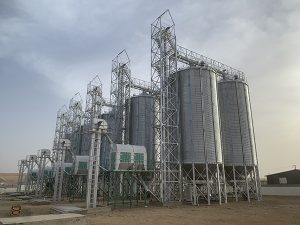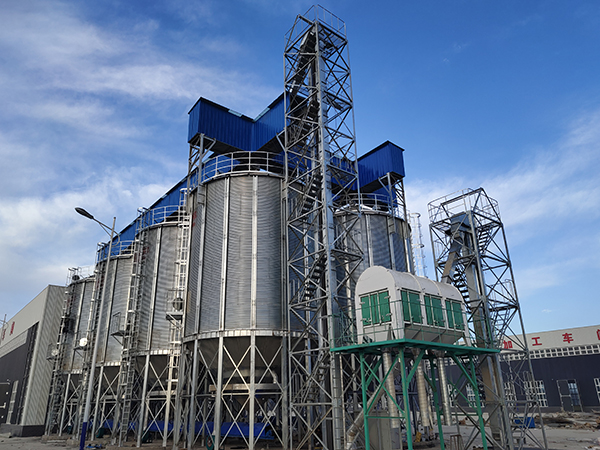Barley cone bottom silo
The Barley cone bottom silo, specifically designed for storing granular agricultural products such as barley, is a type of steel silo with a conical base. This silo facilitates the easy self-discharge of the stored granular
Barley cone bottom silo Introduction
The Barley cone bottom silo, specifically designed for storing granular agricultural products such as barley, is a type of steel silo with a conical base. This silo facilitates the easy self-discharge of the stored granular products under the influence of gravity, making it convenient for subsequent transportation and use.



Barley cone bottom silo features
Conical Bottom
Unlike flat-bottom silos, cone-bottom silos feature a tapered conical base, similar to a funnel shape. This design aids in the natural flow of materials due to their own gravity, reducing the risk of blockages caused by material accumulation, thus ensuring that the barley within the silo can be smoothly discharged from the bottom outlet.
Material Flow Consideration
As a granular cereal with good flowability, barley is well-suited for storage in cone-bottom silos. The conical structure facilitates self-flow of materials, especially suitable for storage systems that require frequent discharge or have a high degree of automation, reducing the need for manual intervention and auxiliary discharge equipment.
Capacity and Size
The capacity of cone-bottom silos can be customized according to actual needs, typically with a larger diameter range (such as 10 to 90 feet, approximately 3 to 27 meters) and a greater height (reaching 30 to 275 feet, approximately 10 to 90 meters). The design of the conical bottom helps provide a large storage volume while occupying a relatively small footprint.
Material and Construction Method
Cone-bottom silos can be made from various materials, such as metal (like steel), concrete, or composite materials. Metal silos may be constructed using welding or bolted connections, facilitating factory prefabrication, transportation, and rapid on-site assembly. Concrete silos are often built using slip-form or jump-form techniques, offering good durability and fire resistance.
Sealing and Moisture Protection
To maintain the quality of barley, cone-bottom silos usually have good sealing performance to prevent moisture, pests, and external environmental factors from affecting the stored grain. This includes the use of appropriate air-tight materials, ventilation systems, and monitoring devices to ensure suitable internal storage conditions.
Discharge System
The bottom of cone-bottom silos is typically equipped with specialized discharge equipment, such as rotary valves, chutes, or conveyor belts, which control the discharge rate and direction of barley, ensuring even and continuous transportation of the material to subsequent processing or transportation stages.

Barley cone bottom silo structure
Silo Roof
The silo roof is the uppermost part of the silo, typically designed to withstand certain loads such as snow and rain. The design of the roof must take into account waterproofing, moisture resistance, and protection against pests and rodents to safeguard the stored barley.
Silo Walls
The silo walls are one of the main structures of the silo, usually made of metal sheets like galvanized corrugated panels. They possess sufficient strength and corrosion resistance to protect the stored barley from external environmental influences. The design of the silo walls also needs to consider the flowability of the material to ensure that barley can flow smoothly out of the silo.
Conical Bottom
The conical bottom is the lower part of the silo, shaped like a cone, which aids in the natural flow of stored barley due to gravity, facilitating discharge.
Support Structure
The support structure is an essential component of the silo, bearing the weight of the entire silo and transferring it to the foundation. The design of the support structure must ensure adequate stability and load-bearing capacity.
Foundation
The foundation is the base of the silo structure, in direct contact with the ground, transferring the load of the silo to the earth. The design of the foundation must consider the ground’s load-bearing capacity and geological conditions to ensure the stability of the silo.


Advantages of barley cone bottom silo
Efficient Space Utilization
The design of the conical bottom silo allows for a compact storage of barley with a smaller footprint compared to traditional warehousing methods, which is particularly beneficial in areas where land resources are scarce.
Minimized Grain Loss
The structure and self-flow design of the silo help to reduce losses of barley during loading and unloading processes, thereby conserving resources and minimizing waste.
Preservation of Grain Quality
Equipped with temperature and humidity control systems, the silo effectively maintains a stable storage environment, reducing the impact of environmental fluctuations on the quality of the stored barley. Additionally, the application of pre-cleaning and drying technologies helps to maintain the quality of the grain.
Reduced Storage Costs
The silo’s design simplifies the loading and unloading procedures, reducing labor requirements and, consequently, labor costs. The compact design also minimizes the use of construction materials, further lowering the costs of silo construction.
Automation and Intelligent Management
Modern conical bottom silos can be equipped with automated loading and unloading systems, storage management systems, and multi-parameter grain condition monitoring systems, enhancing management efficiency and responsiveness.
Adaptability
The design of the conical bottom silo can be adjusted according to the characteristics of different materials, such as flowability and density, making it suitable for storing various types of granular agricultural products.
Environmental Friendliness
The silo is typically constructed with corrosion-resistant materials like hot-dip galvanized corrugated panels, reducing environmental impact and ensuring that the stored barley is protected from external contamination with a well-sealed structure.
High Safety Standards
The conical bottom silo is structurally stable and capable of withstanding certain loads, such as snow and rain, while also featuring fire prevention, pest control, and rodent-proof functions to ensure the safety of the stored barley.
Application scope of barley cone bottom silo
Coban Silo is widely used for grains storage such as wheat, corn, soybean, paddy, rice, soybean meal, barley, malt, sunflower seeds, rapeseeds, peanuts, flour, and other powder materials, oat, special Silo, and seeds, etc.

barley cone bottom silo technical parameters
Scientifically speaking, the Silo capacity should be measured with volume (m3). Even in the same grain Silo, the storage tons will be different for different grains with different densities. The following table is calculated based on a Silo density of 0.75kg/m3, and surely HKB customizes Silo systems unique for you.
| Most Popular Hopper Bottom Steel Silo Technical Specifications | ||||||||
| Capacity | 50Ton | 100Ton | 150Ton | 200Ton | 300Ton | 500Ton | 1000Ton | 1500Ton |
| Model | TCZK
03605 |
TCZK
04507 |
TCZK
05507 |
TCZK
06406 |
TCZK
07307 |
TCZK
07313 |
TCZK
11010 |
TCZK
12811 |
| Diameter(m) | 3.667 | 4.584 | 5.500 | 6.417 | 7.334 | 7.334 | 11.000 | 12.834 |
| Total Height(m) | 9.56 | 12.53 | 13.25 | 12.85 | 14.70 | 21.42 | 20.95 | 23.51 |
| Volume(m³)
Density:0.75ton/m³ |
69 | 150 | 222 | 273 | 415 | 699 | 1346 | 2039 |
| Most Popular Flat Bottom Steel Silo Technical Specifications | ||||||||
| Capacity | 1000Ton | 1500Ton | 2000Ton | 2500Ton | 3000Ton | 5000Ton | 8000Ton | 10000Ton |
| Model | TCK
10014 |
TCK
11915 |
TCK
13715 |
TCK
15514 |
TCK
15518 |
TCK
18321 |
TCK
24718 |
TCK
25621 |
| Diameter(m) | 10.084 | 11.918 | 13.750 | 15.584 | 15.584 | 18.334 | 24.751 | 25.668 |
| Total Height(m) | 18.69 | 20.34 | 20.87 | 20.30 | 24.78 | 28.60 | 26.99 | 30.60 |
| Volume(m³)
Density: 0.75ton/m³ |
1335 | 2009 | 2701 | 2467 | 4145 | 6693 | 10879 | 13484 |
After-sale Service
- – HKB provides advanced grain safety storage technology to assure your grain silo 100% quality stability.
- – grain silo Quality guarantee is one year after installation and commissioning or 18 months after leaving China Port. Maturity is the first.
- – 7 days x 24 hours service, within 24 hours reply/solve of any technical issues upon request.
- – Routinely telephone track to remove all might be problems grain silo or issues guarantying the whole system grain silo long-lasting safety and reliability.
- – HKB will consider all other needs like customs clearance, sea delivery, insurance, customs tax benefit plan, documentation, etc. So our respected Users feel so relaxed and easy to get the grain silo system well.








